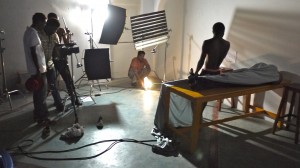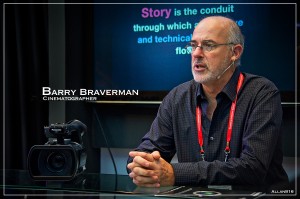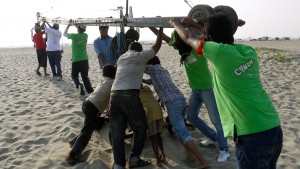Archive for the ‘Business of the Video Shooter’ Category
 3D Training in the UK
3D Training in the UK
The moribund state of 3D has left manufacturers and broadcasters in a state of bewilderment and deep despair. Yet if I’m correct this is about to change in a BIG way with the arrival next year of 3D tablets and mobile phones. The advent of huge numbers of these devices will usher in a vibrant new 3D era, this time driven by non-theatrical applications, from sports and music videos, to remote education, corporate, and medical research.
This week I am in London leading a 3D Camera & Storytelling Workshop for young cinematographers, producers, and directors, at the National Film and Television School. It is a testament to the school to recognize that students must possess fundamental stereo skills in the media world of the very near future.
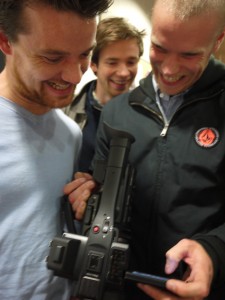
3D Education at the National Film and Television School London • 29 October 2012
 Miracle in Dar es Salaam
Miracle in Dar es Salaam
I’m finally out of Africa and well ensconced now in Paris’ 6th Arrondissement. It’s frankly a welcome change, as I am able at last to recharge my batteries and recover a bit from the sheer exhaustion of the last two months in the trenches of East Africa.
Thinking back over my time in Tanzania and Zanzibar the stories and ideas that are bounding around in my students’ heads never cease to amaze me. One of my students, a modern young Tanzanian woman, reserved and outwardly modest at least, runs her own consulting company in the Tanzanian capital. But put a camera in Suma’s hands and give her several hours of training and you better watch out. She’ll produce a nifty wild-eyed little short film called MONEY HONEYS about two wannabe prostitutes, one from the city, the other from the country, coming to literal fisticuffs in the dirty dusty streets of DSM.
Then there was the quiet guy who works for the famed talk show host Hamza Kosongo at a TV station downtown. For sure I didn’t expect much from Kim. After all I had seen first hand and even participated some rather dreadful local TV programming. But then wow. Kim goes to work and in little more than an hour shooting time produces a veritable comic tour de force beautifully conceived and executed, replete with his own troupe of enormously talented comic actors.
And then there was the young Irish kid, an ex-pat living in this strange and distant country, looking perhaps to find his way in the cinema, and entirely unsure of his abilities as a storyteller. Yannick’s skills needed some direction and discipline but with a little focus they litterally exploded across the screen in his short film A New Pair of Shoes. I love offering my workshops in distant and remote places for this very reason: the surprises that emerge at every turn and twist in the road enthrall and enchant me.
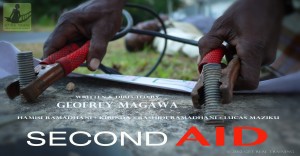
Second Aid by Kim aka Geofrey S. Magawa
 Money Honeys by Ngasuma Kanyeka
Money Honeys by Ngasuma Kanyeka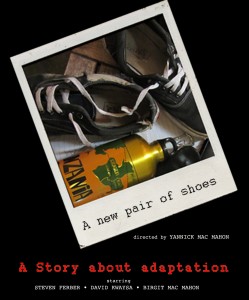
- A New Pair of Shoes by Yannick Mac Mahon
 Storytelling Prowess in Dar es Salaam
Storytelling Prowess in Dar es Salaam
My current two-week preproduciton workshop in Tanzania is revealing a tremendous amount of latent talent about to emerge in this rapidly growing East African country. My sessions sponsored by Swahiliwood MFDI were not mere trivialities but honest to goodness mini-productions, captured with minimal lighting and equipment, but packing a huge emotional and storytelling punch. In particular I wish to cite director John Kallage, young and extraordinarily gifted, and though lacking formal training, has nevertheless amassed a formidable arsenal of camera and directing skills. He is perhaps THE most talented young filmmaker I have EVER encountered in my workshops conducted around the world.
The chase scene is a staple of my camera and storytelling workshops. Indeed I have assigned such an exercise inclusive of a detailed shot list to my classes in over 20 countries. This sequence by John Kallage in Dar es Salaam this week is one of the best. It was captured in a mere 30 minutes, and that includes the time it took to conceive and storyboard the approximate half-dozen scenes.
 Failing Media Education in the West: What’s Wrong With This Picture
Failing Media Education in the West: What’s Wrong With This Picture
This week I’m in Singapore at Broadcast Asia where I’m presenting a series of mini camera workshops from the Panasonic booth on the expo floor. It is obvious to everyone that South Asia and Southeast Asia have emerged as the new epicenters of technology implementation and future growth. It is just as clear based on my professional work and recent workshops in Asia and Africa that the quality of media education in the United States is failing and that professional opportunities in general in the U.S. and Western Europe will continue to diminish in the next decade. It could be simply due to the current economic malaise in Western countries, but I believe it is due to something else, something more insidious.
About six months ago I was invited to conduct a workshop at a prestigious university outside of Paris. My invitation had to apparently clear a number of daunting obstacles including requisite permissions from the dueling teachers unions that are currently wreaking havoc in universities across the country. Ultimately my invitation was denied due to my insufficient qualifications, most notably my ongoing lack of a PhD. It’s bizarre that with thirty-five years of experience on high profile feature films and documentaries, three books, extensive teaching experience in camera training workshops around the world that a PhD from an insolated acadamic institution should rule the roost.
In America a near-comparable level of bullshit applies as academics and their allies conspire to deny their students the media skills they so desperately need. No such restrictions exist however for film and TV schools and universities across Asia.
Here the demand for proficiency and storytelling skills in the media trumps all other considerations. In Bangladesh five new Dhaka TV stations are coming on line in 2012, and station managers are lamenting the lack of sufficiently skilled workers to fill the exploding number of jobs. These days from Bangladesh to Sri Lanka I can assure you no one is asking a PhD from skilled film and TV professionals willing and eager to share their expertise with students and others aspiring to join the burgeoning media workforce.
Perhaps economic desperation in Europe will help motivate the necessary changes in education and the teaching of media crafts. Any way you look at it the the current state of media education in the West is not a pretty scene to behold.
 Report from Cannes
Report from Cannes
 It isn’t too often I have the opportunity to walk the red carpet and hobnob among the industry elite, and, to tell you the truth, with the nearby likes of Bruce Willis, Ed Norton, Jason Schwartzman and Tilda Swinton, I received something less than zero notice strolling up the stairs into the Palais. I shot second unit camera on Moonrise Kingdom, specifically aerial work from the seaplane and several other scenes, and was in Cannes to support my long-time friend and director Wes Anderson, with whom I’ve had a mutually inspiring relationship ever since our first collaboration on Bottle Rocket over twenty years ago.
It isn’t too often I have the opportunity to walk the red carpet and hobnob among the industry elite, and, to tell you the truth, with the nearby likes of Bruce Willis, Ed Norton, Jason Schwartzman and Tilda Swinton, I received something less than zero notice strolling up the stairs into the Palais. I shot second unit camera on Moonrise Kingdom, specifically aerial work from the seaplane and several other scenes, and was in Cannes to support my long-time friend and director Wes Anderson, with whom I’ve had a mutually inspiring relationship ever since our first collaboration on Bottle Rocket over twenty years ago.
In many ways Moonrise Kingdom was perfect to open the festival. Owing to its strong artistic underpinnings and Alexandre Desplat’s very French musical score, the film’s European sensibility is amply reflected in the director’s imprimateur, which is evident in virtually every scene, frame and composition.
Inside the Palais on a sixty-foot screen the digitally projected film appeared breathtaking, and the Super 16-originated production held up extremely well at high magnification, thanks mostly to today’s superior film stocks and Zeiss lenses. In fact, virtually the entire show was shot with Zeiss Super Speeds, specifically the 9.5mm, the beauty and versatility of this now vintage 16mm format lens being apparent throughout the production.
If you’ve never been to Cannes let me just say the festival can be WAY over the top. Between the swarming crowds, screaming paparazzi, run-amok star worship, and the world’s rudest waiters brought in from miles around to man the local cafes, the festival can be a challenging ordeal to navigate and somehow enjoy.
Still the presentation of Moonrise Kingdom in such a venue, before an adoring and appreciative international audience, was a joy to behold. My minor role in the production notwithstanding, it helped restore my faith in the industry, that it is still possible to produce compelling film art exhibiting a high degree of craft and grace.
 Production Bangladesh Style
Production Bangladesh Style
I spent most of March and April in Bangladesh where the market and opportunities for filmmakers are growing exponentially. There is excitement in the air as the country’s rapid growth is producing a shortage of skilled shooters and program producers. Four new TV channels in Dhaka are coming on line this year. In this scene the production grip “crew’ inclusive of several volunteer beach children help force the camera crane through the deep sand at Cox’s Bazar on March 26 Independence Day.
 Embracing New Markets: Can Sony, Panasonic, JVC Adapt in Time?
Embracing New Markets: Can Sony, Panasonic, JVC Adapt in Time?
Assessing the industry landscape, the effects of lingering recession, and the massive losses suffered by the major Japanese players it’s easy to see how NAB 2012 could feature a dearth of new products. Sony, Panasonic, JVC, will offer little if any new gear, while Canon, flush with cash from its high-flying DSLR business, is primed for yet another surge of sales from its ersatz still-and-video cameras and flagship EOS C300.
With the notable exception of Canon the Japanese manufacturers have proven themselves unable to adapt fast enough to changing markets. While the companies’ managers in the U.S. and abroad are in a mad scramble to develop products that consumers and professionals will actually buy, they still cling to the hope that the television stations and the broadcast market that long sustained them will somehow miraculously reappear.
Not a chance.
Of course a spate of innovative new products will be the key to resurrecting the fortunes of Panasonic, Sony and the rest. But so is recognizing the inescapable fact that the broadcast market has substantially disappeared. Other markets will need to be recognized and embraced. The education market is huge and growing, yet Sony in all its wisdom recently laid off or transferred its entire education staff. Go figure.
Canon continues to be the one bright spot in this area. The company just opened a state of the art education facility in the heart of Hollywood, with plenty of room for customer service, cleaning of cameras, classes and workshops. Wow.
It’s nice to see one major Japanese company doing something right. It should give us all a modicum hope. 🙂
 Mega Hype Abounds for Canon’s New Camera
Mega Hype Abounds for Canon’s New Camera
Unless you’re Sony it isn’t too often that a camera manufacturer rents a Hollywood studio, in this case Paramount, and hires an A-list director, in this case, Martin Scorsese, to do the introductory honors. But that’s exactly the case on November 3 as Canon will announce its most professional large-format camera yet from its underrated and (until now) ignored video division. Not another DSLR variant, the new camera is expected to offer very high resolution at 4K or greater, 4:2:2 intraframe compression, and practical recording to SSD onboard storage. Any way you look at the new camera, this is an aggressive upscale move, and a veritable shot across the bow to Sony’s best-seller F3 model, which has dominated the scene for most of the past year.
Given Canon’s propensity for excellent controls, rugged construction, and operational ease, this camera could quickly become a major player in the large-sensor camera wars, especially given the quality of Canon optics that will surely go with it. As Panasonic fumbles and Sony shakes in its boots, the stakes couldn’t be greater for the major camera manufacturers (and RED) as we near the moment of the great announcement amid the pomp and circumstance this coming Thursday.
Stay tuned. I’ll be all over this one.
 Your Competitive Advantage
Your Competitive Advantage
In these challenging times we need to take a close look at ourselves as shooters and digital storytellers. Just like some countries are particularly adept at manufacturing certain things like automobiles, TVs and precision watches, so must you the resourceful multi-talented shooter consider your competitive advantage over other shooters vying for the same assignments. Maybe you are a Final Cut Pro maven or skilled After Effects artist. Maybe you are skilled at designing websites or you’re an accomplished linguist and able to speak multiple languages. For a shooter these are compelling ancillary attributes that can be exploited to the max in order to attract potential clients. I happen to be known as something of a fireman in the business; when things go wrong on a shoot somewhere in the world, I will often get a call to round up my commando-style team and fly off somewhere to shoot an overlooked background scene, establishing shot – or take over shooting an entire project. The trick here is to understand and embrace your clients’ fears: if they’re worried about shooting tapeless to flash memory, become adept at handling this new style workflow. Understand archiving protocols and backups, and how to apply best handling practices even in the heat of battle on a professional set. Exude confidence at all times and perform with absolute reliability and good cheer. You’ll get the work you’ll seeking – even through these tough economic times.
 Work for free!
Work for free!
A lot has been said of the freelancer’s business today. More than ever given these tough economic times the freelancer must be creative in marketing himself and his skills. Problem is there seems to be a plethora of low or non-paying jobs out there. There’s no shortage of work if you want to work for free, And sometimes I do exactly that.
Working for free is completely different from working for low-pay. Working at less or much less than your customary rate cheapens your services and diminishes your stature in the eyes of your client. It opens yourself to a wide range of abuses, long hours and lack of respect. But working for free — ah, that’s a horse of a different color. Now YOU hold all the marbles – not your employer. Folks, this is psychological warfare – and you’d be very wise to engage in it! You’re doing your client a colossal favor, you’ve demonstrated your willingness to be flexible during the recession, and you’ve (hopefully) proven yourself indispensable to your client.
There you go. Think of it as “career development” or “targeted promotion” on your part. If you choose your employer carefully, the days you work for free can be the most lucrative days of your career.
